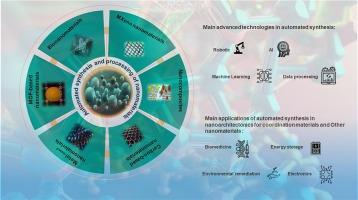当前位置:
X-MOL 学术
›
Coord. Chem. Rev.
›
论文详情
Our official English website, www.x-mol.net, welcomes your
feedback! (Note: you will need to create a separate account there.)
Automated synthesis and processing of functional nanomaterials: Advances and perspectives
Coordination Chemistry Reviews ( IF 20.3 ) Pub Date : 2024-10-11 , DOI: 10.1016/j.ccr.2024.216249 Masoud Negahdary, Samuel Mabbott
Coordination Chemistry Reviews ( IF 20.3 ) Pub Date : 2024-10-11 , DOI: 10.1016/j.ccr.2024.216249 Masoud Negahdary, Samuel Mabbott

|
Integration of nanotechnology and information technology has seen an enormous leap in growth with the invention of automated systems capable of synthesizing and processing nanomaterials, thus presenting notable advantages over traditional techniques, particularly improved accuracy, reproducibility, and scalability. Automated systems minimize human errors, and nanomaterials can also be produced on a large scale at a speedy rate while controlling material properties in great detail, hence giving rise to specific functionalities that may not be realized through manual methods. Here, the most recent advancements in automated synthesis and processing of nanomaterials will be discussed, covering various types of nanomaterials which can be categorized as either coordinated or non-coordinated including metal-organic frameworks (MOFs), MXenes, quantum dots (QDs), nanocomposites, carbon-based nanomaterials, and others. Additionally, we will address the technological breakthroughs that have led to automation, from microfluidic synthesis to robots coupled with artificial intelligence (AI) and machine learning. In a new age of synthetic approaches, advanced developments within automation provide the controllable and predictable production of high-quality known nanomaterials while also providing the catalyst for generating novel nanomaterials. The primary object of this review is to provide a comprehensive and critical assessment of the current trends and breakthroughs in automated nanomaterial synthesis and processing, which brings out the research principles and the advantages of different automated platforms. It is equally important to address some limitations of current approaches to ignite a discussion about future research directions.
中文翻译:

功能纳米材料的自动化合成和加工:进展和前景
随着能够合成和加工纳米材料的自动化系统的发明,纳米技术和信息技术的整合取得了巨大的飞跃,与传统技术相比具有显着优势,特别是提高了准确性、可重复性和可扩展性。自动化系统最大限度地减少了人为错误,纳米材料也可以快速大规模生产,同时非常详细地控制材料特性,从而产生可能无法通过手动方法实现的特定功能。在这里,将讨论纳米材料自动合成和加工的最新进展,涵盖可分为配位或非配位的各种类型的纳米材料,包括金属有机框架 (MOF)、MXenes、量子点 (QD)、纳米复合材料、碳基纳米材料等。此外,我们还将讨论导致自动化的技术突破,从微流体合成到机器人与人工智能 (AI) 和机器学习相结合。在合成方法的新时代,自动化领域的先进发展提供了高质量已知纳米材料的可控和可预测生产,同时也为生产新型纳米材料提供了催化剂。本综述的主要目的是对自动化纳米材料合成和加工的当前趋势和突破进行全面和批判性的评估,从而带出不同自动化平台的研究原理和优势。解决当前方法的一些局限性以引发关于未来研究方向的讨论同样重要。
更新日期:2024-10-11
中文翻译:

功能纳米材料的自动化合成和加工:进展和前景
随着能够合成和加工纳米材料的自动化系统的发明,纳米技术和信息技术的整合取得了巨大的飞跃,与传统技术相比具有显着优势,特别是提高了准确性、可重复性和可扩展性。自动化系统最大限度地减少了人为错误,纳米材料也可以快速大规模生产,同时非常详细地控制材料特性,从而产生可能无法通过手动方法实现的特定功能。在这里,将讨论纳米材料自动合成和加工的最新进展,涵盖可分为配位或非配位的各种类型的纳米材料,包括金属有机框架 (MOF)、MXenes、量子点 (QD)、纳米复合材料、碳基纳米材料等。此外,我们还将讨论导致自动化的技术突破,从微流体合成到机器人与人工智能 (AI) 和机器学习相结合。在合成方法的新时代,自动化领域的先进发展提供了高质量已知纳米材料的可控和可预测生产,同时也为生产新型纳米材料提供了催化剂。本综述的主要目的是对自动化纳米材料合成和加工的当前趋势和突破进行全面和批判性的评估,从而带出不同自动化平台的研究原理和优势。解决当前方法的一些局限性以引发关于未来研究方向的讨论同样重要。


















































 京公网安备 11010802027423号
京公网安备 11010802027423号